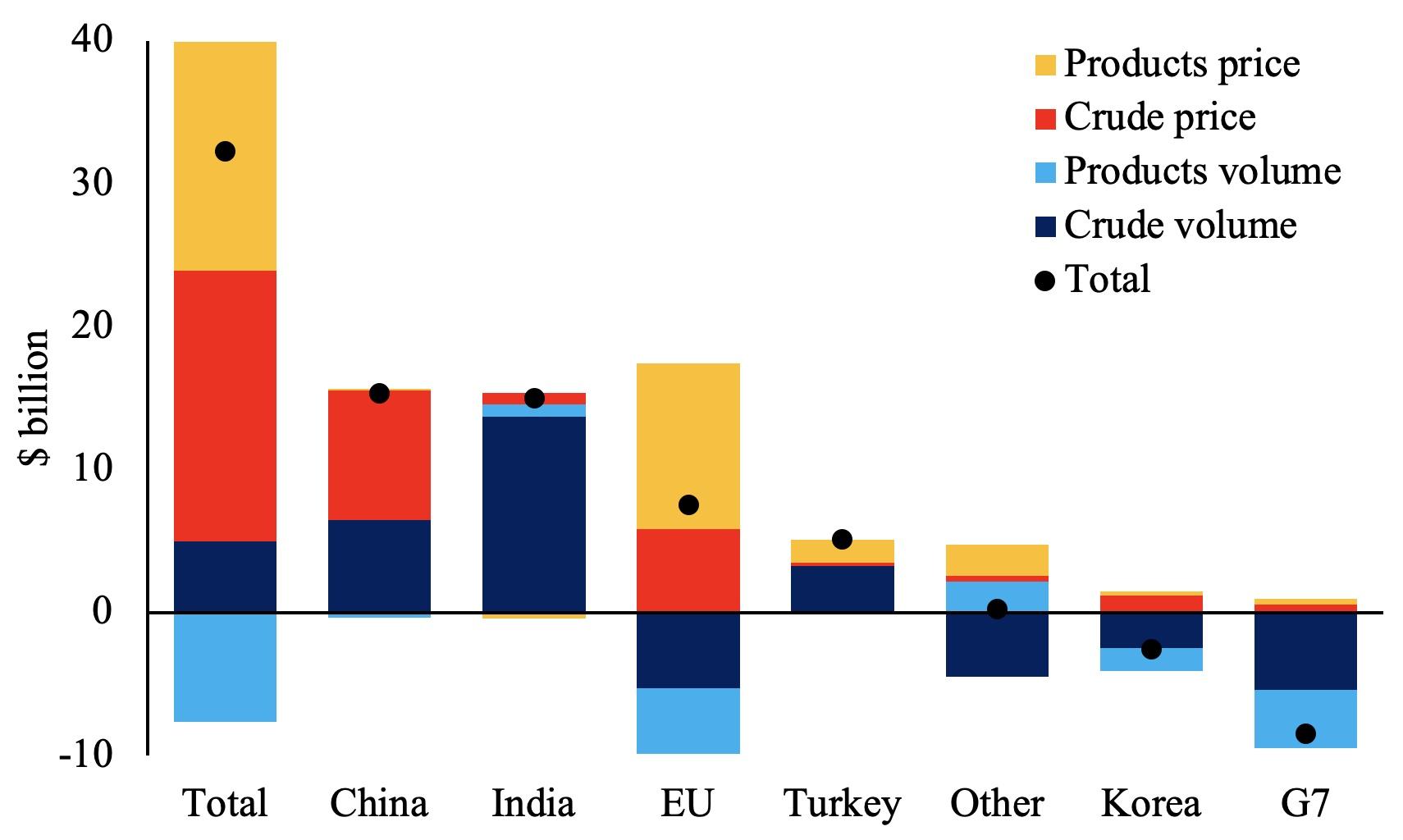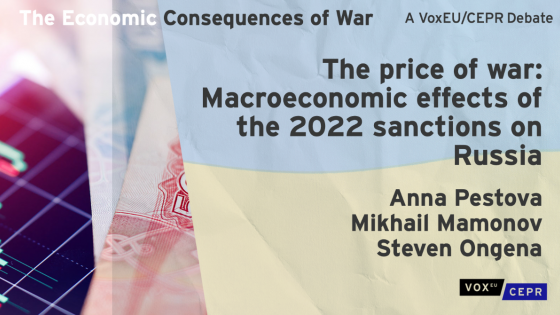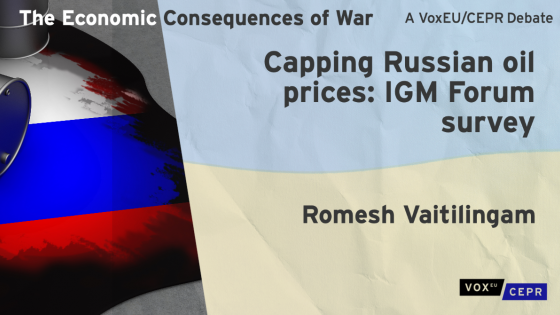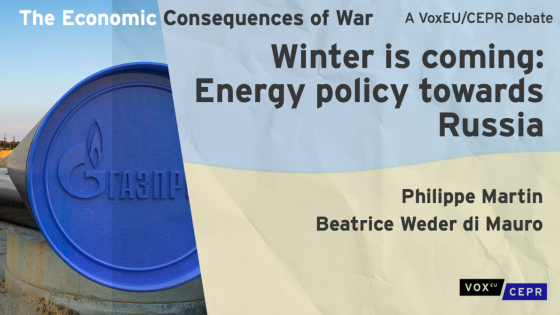Unprecedented economic sanctions have been imposed on Russia since its brutal invasion of Ukraine in February 2022. The impact of these sanctions – and, in particular, their ability to curb government resources to finance the war – is a topic of keen policy interest (e.g. Garicano et al. 2022, Demertzis et al. 2022). In our recent work (Babina et al. 2023), we use a unique comprehensive transaction-level dataset on Russian exports and imports to evaluate the impact of international sanctions — specifically measures targeting Russian crude oil and oil products exports, as they are the key drivers of the country’s external accounts, its economy, and government finances. Sanctions on Russian hydrocarbon exports did not begin in earnest until the EU seaborne crude oil embargo and the G7 price cap mechanism took effect on 5 December 2022. However, with the EU embargo on oil products in place as well since 5 February 2023, a significant share of oil exports is now sanctioned – 51% of crude oil and 64% of oil products, in 2021 volume terms.
While volumes of energy imports from Russia by Ukraine’s allies fell markedly during the second half of 2022 – including a dramatic moving away from Russian gas – soaring prices supported overall Russian energy earnings and led to record-high exports of $532 billion, an increase of 21% over 2021. At the same time, imports fell significantly in 2022 to $217 billion, a decline of 18% over 2021, due to a sharp decline in imports in the second quarter in response to import sanctions, even though imports effectively recovered to their pre-invasion levels by the end of the year. The result was an all-time high trade surplus of $316 billion (see Figure 1).
Figure 1 Summary of Russian trade
Source: Federal Customs Service, authors’ calculations.
Russia’s external environment has always been determined by the country’s exports of oil and natural gas, with global energy prices being the driving force behind swings in the trade balance. Exports of oil and gas reached $333 billion in 2022 – representing 63% of total goods exports – with crude oil accounting for $142 billion, oil products for $83 billion, and natural gas for $108 billion (see Figure 2). Russia’s ability to redirect crude shipments from Western countries – which undertook considerable efforts to reduce their dependence on Russian oil – was critical for keeping up volumes, while elevated global oil prices drove up export revenues. In the area of natural gas, soaring prices more than offset sharp volumes declines as a result of Russia’s decision to cut supplies to Europe in the second half of 2022. Full-year numbers conceal that the external environment was worsening rapidly by the end of 2022 and projected to worsen further in 2023.
We estimate that higher world oil prices drove up Russian oil export revenues by around $35 billion in the post-invasion period (March-December 2022) compared to the corresponding period in 2021 – of which $19 billion can be assigned to crude oil prices and $16 billion to oil product prices (see Figure 3). The total effect from volume changes was slightly negative with the increase in crude oil volumes almost offsetting the decrease in oil product volumes. Russia was able to redirect crude oil to alternative markets, including China, which continued to buy large quantities, and India, which emerged as the most important new destination. These two countries, together with Turkey, have replaced the EU as the most important buyer of Russian crude oil, and accounted for two-thirds of Russian exports in 2022Q4 versus less than one-third in 2022Q1.
In contrast, oil product volumes fell due to G7 countries’ reduction of purchases in the absence of significant additional sales to alternative markets. In the case of EU countries, higher prices offset volume reductions for both crude oil and oil products, leading to payments to Russia $7.6 billion higher than in March-December 2021.
Figure 2 Composition of Russian goods exports
Source: Federal Customs Service, authors’ calculations
What should not be overlooked, however, is that the sizable discount on Russian crude oil during most of 2022 reduced the country’s export earnings considerably. Although the EU embargo and G7 price cap were not implemented until December, Russia had to accept significantly lower prices to maintain export volumes. We estimate that the widening spread between Russian export prices and Brent crude, which soared to above $30/barrel in April-May at the peak of world oil prices (see Figure 4), shaved off more than $30 billion, or above $3 billion per month, from crude oil export revenues compared to a scenario in which Russia received close to market prices. This also suggests that Russia chose not to reduce volumes in the face of downward pressure on prices.
Prices for Russia’s oil exports have been subject to much speculation in the absence of reliable, comprehensive data: our dataset provides a unique picture of the prices that Russia is charging for its oil and oil product exports. Significant changes to trade patterns have led to fragmentation in the market for Russian crude oil and, as a result, to diverging prices. Until Russia’s full-scale invasion of Ukraine, prices for Russian crude did not differ significantly depending on the specific export channel and remained close to world oil prices. This has changed dramatically. The key driver here are fundamental changes in demand from different buyers in the context of oil infrastructure geared toward traditional export partners such as Europe and geographically set up for this purpose.
Figure 3 Contributions to change in oil payments
Source: Federal Customs Service, authors’ calculations
We find that, essentially, two different markets have emerged for Russian crude oil. The loss of the country’s most-important export market for crude — Europe — freed up capacities at ports, primarily in the Baltic Sea, whose geographic location is not suited for exports to ‘new’ customers such as India. To support export volumes, we find that Russia appears to be providing steep discounts in this market; for instance, in the post-embargo period, Indian buyers paid around $17/barrel less for Baltic Sea crude shipments than Europeans. As demand via other export channels did not change materially, we see much higher prices in the Pacific Ocean ports. Despite popular beliefs that China is getting large discounts on its purchases of Russian crude oil, this appears to be incorrect. In fact, we calculate an average price of $84/barrel paid by China based on transactions reported to Russia’s customs service, on par with the world oil prices.
For overall prices, we find smaller discounts than reported in other sources, and export prices did not drop in line with Urals crude post-embargo. Our estimated average oil prices could indicate that Russia is selling crude oil above the G7 price cap of $60/barrel and that the discount versus Brent narrowed towards the end of the year (from $30/barrel at the peak of oil prices in late spring to around $7/barrel in December). While the lag in customs data-based prices versus market survey-based ones may play a role, these high prices also indicate Russia’s ability to circumvent the price cap: while around 50% of crude oil may be transported via the unsanctionable shadow fleet, the remaining shipments should still be subject to the cap as they involve Western shipping services. It is an open question whether prices for Russian crude exports have deteriorated significantly in the first months of 2023, and future iterations of our paper will zoom in on this question.
Figure 4 Crude oil prices
Source: Bloomberg, Federal Customs Service, authors’ calculations
The effectiveness of the G7 price cap on Russian crude oil is much debated. As the introduction of the cap coincides with the taking effect of the EU embargo, it is somewhat difficult to distinguish between effects of the two. Most observers seem to believe that the embargo is the primary driver behind current oil market developments, and we tend to agree. The key argument is the time dimension. The fragmentation of the market for Russian crude oil — and resulting price dynamics — is a development that began in the spring of last year and continued throughout 2022 as decisions on sanctions, including the embargo, were made and implemented. This is not to say that the price cap is unimportant, provided there is strict enforcement and compliance. Indeed, considering the embargo is resulting in a negligible share of Russian oil exports going to Western countries, the enforcement of the price cap is a critical remaining policy tool.
Finally, we evaluate that an earlier embargo or an earlier crude oil price cap could have reduced Russian export earnings significantly in 2022 and, in turn, weighed on Russian fiscal revenues and the ability to finance the war. We find that a European embargo in the immediate aftermath of the invasion would have reduced Russian crude oil export revenues by $46 billion, or roughly one-third of the total. Had the embargo taken effect after the EU’s sixth sanctions package was agreed upon in July, the decline would have been around $25 billion. A tight international price cap implemented in March 2022 in place of an embargo would have been at least as effective, provided broad compliance ensured by strict enforcement.
In the area of oil products, any redirection of exports in the aftermath of the EU embargo, which took effect on 5 February 2023, will be a challenge. The countries that now account for a dominant share of Russian crude oil exports, such as China, India, and Turkey, play a much smaller role with regard to oil products as they all have their own developed refining sectors. In fact, it appears that countries which banned Russian oil products are increasingly acquiring these goods via places such as India and Turkey, which stepped up imports of Russian crude oil for this purpose. This does not mean that sanctions are circumvented, as this effectively removes profits from Russia’s refining industry and may force painful reductions in refining activities.
To summarise, our findings suggest that the EU embargo on Russian oil played a key role in driving the deep discounts on Russian oil. Going forward, the enforcement of sanctions on Russian oil exports is critical, including ensuring compliance with price cap-related restrictions on shipping, maritime insurance, and other services. This is of particular importance as sales to non-sanctions coalition countries now dominate Russia’s oil trade. Furthermore, our finding of a significant share of Russian crude oil being sold well above the price cap level of $60/barrel urgently calls for further investigation of these transactions and reinforces the need for stepped-up enforcement. We further believe that the price caps on crude oil should be lowered as soon as possible. While we appreciate concerns regarding market stability and rising oil prices, the post-embargo period demonstrates that Russia is willing to accept lower prices on some of its shipments and is unlikely to cut volumes as long as the price cap remains above production costs. As our analysis suggests, a lower cap could significantly impact Russia’s earnings from oil exports, and thus we support the International Working Group on Russian Sanctions’ recent call for a $35/barrel cap and propose a similarly aggressive approach as far as price caps on oil products are concerned (International Working Group on Russian Sanctions 2022).
Authors’ note: The opinions expressed in this column are those of the authors and do not represent the views of the organisations they are affiliated with.
References
Babina, T, B Hilgenstock, O Itskhoki, M Mironov and E Ribakova (2023), “Assessing the Impact of International Sanctions on Russian Oil Exports”, SSRN Working Paper, February.
Demertzis, M, B Hilgenstock, B McWilliams, E Ribakova and S Tagliapietra (2022), “How Have Sanctions Impacted Russia?”, Bruegel, 26 October.
Garicano, L, D Rohner and B Weder di Mauro (2022), Global Economic Consequences of the War in Ukraine: Sanctions, Supply Chains and Sustainability, CEPR Press.
The International Working Group on Russian Sanctions (2022), “Working Group Paper #10: Implementation of the Oil Price Cap”, November.











